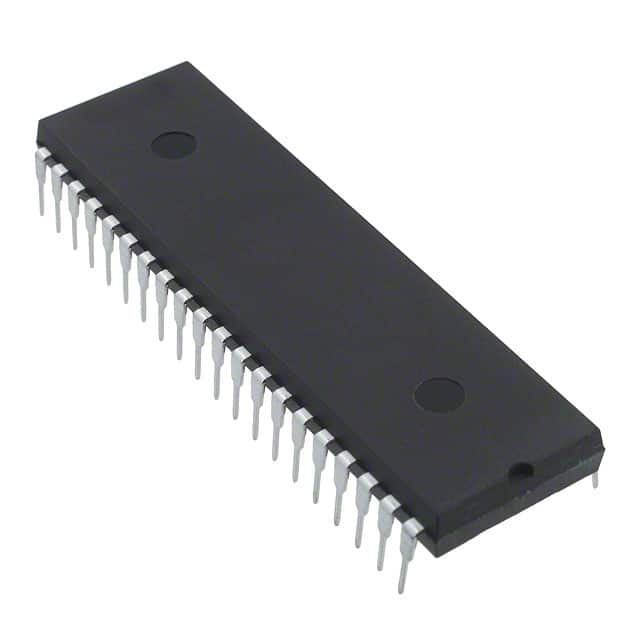Xem thông số kỹ thuật để biết chi tiết sản phẩm.

TMS320C10NL
Basic Information Overview
- Category: Digital Signal Processor (DSP)
- Use: Signal processing in various applications
- Characteristics: High performance, low power consumption
- Package: 40-pin PDIP (Plastic Dual In-line Package)
- Essence: Advanced DSP for real-time signal processing
- Packaging/Quantity: Available in tubes or trays, quantity varies
Specifications
- Architecture: Harvard architecture
- Clock Speed: 20 MHz
- Data Bus Width: 16 bits
- Program Memory Size: 8K words
- Data Memory Size: 256 words
- Instruction Set: TMS320
- Operating Voltage: 5V
- Power Consumption: 1.2W
Detailed Pin Configuration
The TMS320C10NL has a total of 40 pins. The pin configuration is as follows:
- VCC - Power supply voltage
- GND - Ground
- X0 - Crystal oscillator input
- X1 - Crystal oscillator output
- RESET - Reset input
- INT - Interrupt input
- HOLD - Hold input
- HOLDA - Hold acknowledge output
- A0-A15 - Address bus
- D0-D15 - Data bus
- RD - Read control signal
- WR - Write control signal
- AS - Address strobe control signal
- DS - Data strobe control signal
- CLKOUT - Clock output
- TEST - Test mode input
- DBIN - Data bus invert control signal
- PSEN - Program store enable control signal
- READY - Ready output
- VSS - Ground
...
Functional Features
- High-speed arithmetic and logic operations
- Efficient multiply-accumulate (MAC) unit
- On-chip program memory
- Flexible I/O options
- Interrupt handling capability
- Power-saving features
Advantages and Disadvantages
Advantages: - High performance for real-time signal processing - Low power consumption - On-chip program memory reduces external memory requirements - Flexible I/O options allow easy integration with various systems
Disadvantages: - Limited data memory size - Relatively low clock speed compared to newer DSPs - Availability of alternative models with more advanced features
Working Principles
The TMS320C10NL is based on the Harvard architecture, which separates program and data memory. It uses a high-speed arithmetic and logic unit (ALU) for efficient signal processing operations. The processor fetches instructions from the program memory, performs calculations on the data using the ALU, and stores the results back in the data memory.
Detailed Application Field Plans
The TMS320C10NL is widely used in various applications that require real-time signal processing, such as:
- Audio and speech processing
- Image and video processing
- Communication systems
- Control systems
- Instrumentation and measurement devices
Detailed and Complete Alternative Models
- TMS320C10
- TMS320C10A
- TMS320C10B
- TMS320C10C
- TMS320C10D
These alternative models offer improved features and capabilities compared to the TMS320C10NL.
In conclusion, the TMS320C10NL is a powerful digital signal processor designed for real-time signal processing applications. Its high performance, low power consumption, and flexible I/O options make it suitable for a wide range of applications. However, it has certain limitations such as limited data memory size and relatively lower clock speed compared to newer DSPs. There are alternative models available with more advanced features for those seeking enhanced capabilities.
Liệt kê 10 câu hỏi và câu trả lời thường gặp liên quan đến ứng dụng TMS320C10NL trong giải pháp kỹ thuật
Sure! Here are 10 common questions and answers related to the application of TMS320C10NL in technical solutions:
Q: What is TMS320C10NL? A: TMS320C10NL is a digital signal processor (DSP) chip developed by Texas Instruments.
Q: What are the key features of TMS320C10NL? A: TMS320C10NL features a 16-bit fixed-point architecture, on-chip memory, parallel processing capabilities, and a rich set of peripherals.
Q: What are the typical applications of TMS320C10NL? A: TMS320C10NL is commonly used in applications such as audio processing, speech recognition, telecommunications, motor control, and industrial automation.
Q: How does TMS320C10NL handle parallel processing? A: TMS320C10NL has multiple execution units that can operate simultaneously, allowing for efficient parallel processing of data.
Q: Can TMS320C10NL be programmed using high-level languages? A: Yes, TMS320C10NL can be programmed using assembly language or higher-level languages like C or C++ with the help of appropriate development tools.
Q: Does TMS320C10NL support floating-point arithmetic? A: No, TMS320C10NL is a fixed-point DSP and does not have built-in hardware support for floating-point arithmetic.
Q: What is the maximum clock frequency of TMS320C10NL? A: The maximum clock frequency of TMS320C10NL is typically around 20 MHz.
Q: Can TMS320C10NL interface with external memory devices? A: Yes, TMS320C10NL supports external memory interfaces, allowing for expanded storage capacity if needed.
Q: Are there any development tools available for TMS320C10NL? A: Yes, Texas Instruments provides a range of development tools, including compilers, assemblers, debuggers, and emulators, specifically designed for programming and debugging TMS320C10NL-based systems.
Q: Is TMS320C10NL still widely used today? A: While TMS320C10NL was popular in the past, it has been largely replaced by more advanced DSP chips. However, it may still be used in legacy systems or specific applications where its features are sufficient.

